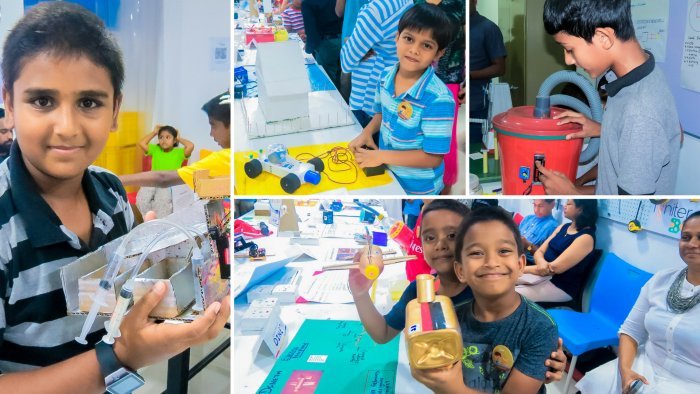Chaos. Pure unadulterated chaos. That’s what awaited us when we walked into the IgniterSpace Narahenpita branch last Sunday evening. One walking in would see kids running in different directions, some carrying gadgets from airplanes to hydraulic systems, others being followed by stressed-out mothers carrying signs. This was the Young Innovators Exhibition 2018.
This was essentially an exhibition of products and inventions made by a group of kids after a course of 8 months. IgniterSpace, where children are encouraged to be innovative without just following instructions, is one of the first initiatives to introduce makerspaces to Sri Lanka.

Last Sunday (25th of Feb) was the 8th batch of young innovators exhibiting and pitching their products proudly. Jehan Wijesinghe, CEO of IgniterSpace, stated that looking back at all the exhibitions from the beginning, “every time it’s a surprise.” Well, it certainly was a big surprise this time.
From mopping cups and vacuum cleaners to gardening bots and magnet cranes, a wide range of new and innovative products were in front of our inquisitive eyes last Sunday. We also noticed that according to what type of project they had developed, they were proudly wearing a badge on their T-shirts. We met multiple electronics gurus, innovation engineers, programming gurus, problem solvers and experimenters. Out of those, a few projects caught our eye in particular.
Damien and his Dog Alarm
Damien De Cruz, for his project, chose to solve a problem around his own neighborhood. According to him, his family had a lot of trouble from stray dogs walking in and messing up the trash. He wanted to find a solution which not only would not hurt the dogs but not disturb the neighbors as well.

The result was an alarm. Common and expected, you say? Well, this alarm has a difference. We can’t hear it. With some research, Damien has designed the alarm to operate at a frequency too high for humans to hear. It also has sensors which activate when someone (a dog) comes near, thus driving it off.
Chanidu and Tharukas’ Dark Sensor
Two brothers, Chanidu and Tharuka, also had the same idea of solving an everyday home problem. They noticed that in many households, occupants are either too busy or don’t notice when it becomes dark. Subsequently, they forget to close the doors and windows, letting mosquitoes and other troublesome creepy crawlies in.
In a very organized pitch divided between the two of them, they described that the solution was a system that is designed to close automated doors and windows as soon as it gets dark. This is done through a dark sensor which will activate as soon as the light levels go down below a certain level. They also showcased a prototype of the system, with explanations on what they used, intended audience, and how they implemented it.
Sock Drying by Yenula
While he didn’t pick a problem as large as his peers did, Yenula came up with an ingenious solution for a very common household problem. Smelly socks. His machine, designed to quickly dry small items of clothing like socks and gloves, is quite a sight to behold. Needless to say, it was one of the hottest projects on the table!

Simply consisting of a wooden box, the inside was lined with insulation foil, with 5 high powered light bulbs fixed to the top. There was also a fan at the very back. The combination of all these elements meant that a lot of heat would be produced in a very short time, effectively drying out your wet socks and/or gloves.
Flood Alarm by Moksha
Moksha thought about the hardships that people in Sri Lanka generally undergo. Knowing that floods were a real threat for many, he strived to find an easy warning system that would be able to deliver apt warnings to citizens nearby.

Moksha’s system uses a ball that floats, which connects to a circuit. His device would measure the rain flow, and once the rain reaches certain levels, the warnings would light up and sound the alarm.
Hirun and the Smart Garbage Disposal System
Hirun managed to develop an entire system as his project. At 14 years old, his system remains surprisingly advanced for his age. His problem was the garbage bins usually overflowing before the garbage collectors came and collected the trash. His solution lets garbage collectors keep track of the garbage and come and collect/drop them off.

This system consisted of two parts. The sensor located on the bin, which measured the distance between the lid and the garbage, and the mobile app. Hirun developed the app by himself, and it’s certainly a handy little thing. The app shows the current status of the bin (empty, medium, full) with an alarm going off when it becomes full.
Other projects we found inside IgniterSpace
While these five were certainly our definite top five picks for the day, certain other projects also caught our eye. First was Dulya, the only girl in the exhibition out of roughly 40 participants. Dulya, 12, showcased a project called Mad Paint, which was like MS paint, just brighter and with a different layout. We were also impressed by Heshitha, who had developed a walking robot despite being 6 years of age.
In addition, we also saw projects like Kavin’s Garden bot, Chaneth’s water overflow alarm, Binuk and his mopping cups, Caleb’s shoe shiner, Lithika’s floor cleaner and Ashen’s vacuum cleaner.

Despite all these amazing projects, the toughest part about makerspaces, Jehan states, is getting parents to accept the idea. While Sri Lanka is still big on the traditional education system, he says, parents just want their kids to be successful and happy. And at the end of the day, what IgniterSpace tries to do is to show parents that their kids can be both by being creative.
However, he said, one of the major differences he saw this time was that he found more parents accepting the idea and supporting their children. He shared that most kids now look for solutions to real-world problems in their projects rather than just doing something for fun, which was their aim all along. He expects, with future batches, we’ll see more solutions to complex problems. If you wish to have your kids join the next batch of IgniterSpace, click here.







GIPHY App Key not set. Please check settings